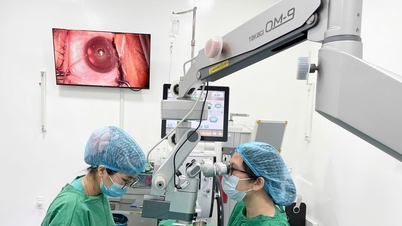
Recently, the Emergency Department of Quang Nam Hospital admitted patient HTHN (18 years old, Tra Mai commune, Nam Tra My) to the hospital with symptoms of colic pain in the right iliac fossa accompanied by fever and nausea, no pain relief position. The patient had no history of trauma, no internal medical conditions.
Notably, the patient had symptoms on the 4th day after giving birth. The lower level hospital transferred the patient to Quang Nam General Hospital with a diagnosis of appendicitis in the patient on the 4th day postpartum.
At the emergency department, the patient was conscious, had a fever of 38 degrees Celsius, no signs of infection, no edema, no chest pain, no difficulty breathing, and no swelling or pain in both legs. The patient had abdominal pain in the right iliac fossa, soft lower abdomen, no abdominal wall reaction, and no obvious mass was detected in the area where the patient had pain. The patient was diagnosed with acute abdominal pain and an abdominal ultrasound was ordered. The ultrasound image detected a lesion suspected of ovarian vein thrombosis spreading to the inferior vena cava.
The patient was then given an emergency consultation with the cardiology team, and was ordered to have an abdominal CT scan with medication to clarify the diagnosis. The scan results showed acute thrombosis of the right ovarian vein, spreading to the inferior vena cava with surrounding inflammatory lesions causing right ureteral stenosis, and grade I hydronephrosis of the right kidney.
Doctor CKII. Nguyen Luong Quang - Head of the Department of Cardiology, Quang Nam General Hospital said that the patient was then transferred to the Cardiology Department for treatment according to the protocol for postpartum ovarian vein thrombosis.
After 1 week of treatment, the patient's abdominal pain was gone, the abdomen was soft, and ultrasound examination showed that the mixed echogenic mass in the right abdomen had decreased in size and echogenicity. The patient was discharged from the hospital with medication prescribed as an outpatient, and scheduled for a follow-up examination after 1 month.
This is a very rare case, if not diagnosed correctly and treated promptly it will be very dangerous.
Doctor CKII. Nguyen Luong Quang
According to Dr. Quang, the classic clinical manifestations of ovarian vein thrombosis have 3 symptoms, including pelvic pain, fever and a mass in the lower abdomen. Some other symptoms may also occur such as rapid heart rate, low blood pressure, rapid breathing, nausea, vomiting... Symptoms usually occur in the first 4 weeks after giving birth, most commonly in the first 10 days.
Ovarian vein thrombosis occurring in the right ovarian vein is more common, accounting for up to 90% of cases. This is due to the longer length of the right ovarian vein, fewer functional valves, and the uterus rotating to the right during pregnancy.
“This leads to misdiagnosis with appendicitis because of the similarity of symptoms and pain location (appendicitis also causes fever and pain in the right iliac fossa). Therefore, it is necessary to take a medical history (pregnancy), conduct a careful clinical examination, and direct appropriate tests, especially abdominal ultrasound, CT scan, and MRI if suspected,” said Dr. Quang.
Ovarian vein thrombosis (OVT) was first described by Austin in a postpartum woman in 1956. It is a rare emergency condition associated with the postpartum period, abortion, malignancy, abdominal and pelvic surgery, pelvic inflammatory disease, inflammatory bowel disease, post-Covid-19 infection...
This rate occurs in 0.05% to 0.16% of pregnant women, mainly in the postpartum period, estimated to be up to 2% of cesarean sections. Common causes in pregnancy are poor blood circulation in the lower abdomen causing venous stasis, physiological hypercoagulability during pregnancy and venous endothelial damage due to infection or vascular trauma.
According to Dr. Nguyen Luong Quang, this is a rare disease so there has not been any large-scale research to develop specific treatment guidelines for OVT. Previous treatment guidelines include antibiotics, hysterectomy, laparoscopic thrombectomy, ovarian vein ligation, ovarian vein resection, inferior vena cava ligation and inferior vena cava filter placement, which have been recommended by many experts.
“Because of the nonspecific manifestations of ovarian vein thrombosis, accurate and timely diagnosis is required. Delay in diagnosis can lead to potentially life-threatening complications, including ovarian abscess, ovarian infarction, septic thromboembolism, extension into the inferior vena cava (IVC), pulmonary embolism (PE), uterine necrosis, and ureteral compression,” Dr. Quang shared.
Ovarian vein thrombosis is a rare, potentially life-threatening emergency that is easily missed. Therefore, diagnosis should be based on clinical symptoms and imaging studies. This condition should be considered when there are symptoms of pelvic pain, fever, and a mass in the lower abdomen, especially in postpartum women with an inflammatory condition.
Doctor CKII. Nguyen Luong Quang
Source: https://baoquangnam.vn/benh-vien-da-khoa-quang-nam-dieu-tri-thanh-cong-mot-truong-hop-mac-benh-hiem-gap-3154286.html





![[Photo] Prime Minister Pham Minh Chinh meets with Hungarian President Sulyok Tamas](https://vphoto.vietnam.vn/thumb/1200x675/vietnam/resource/IMAGE/2025/5/29/dbcaa73e92ea4448a03fe1d0de6d68e8)
![[Photo] Vietnamese and Hungarian leaders attend the opening of the exhibition by photographer Bozoky Dezso](https://vphoto.vietnam.vn/thumb/1200x675/vietnam/resource/IMAGE/2025/5/29/94d8ceca5db14af3bf31285551ae4bb3)
![[Photo] Prime Minister Pham Minh Chinh receives leaders of Excelerate Energy Group](https://vphoto.vietnam.vn/thumb/1200x675/vietnam/resource/IMAGE/2025/5/29/c1fbe073230443d0a5aae0bc264d07fe)


















































































Comment (0)